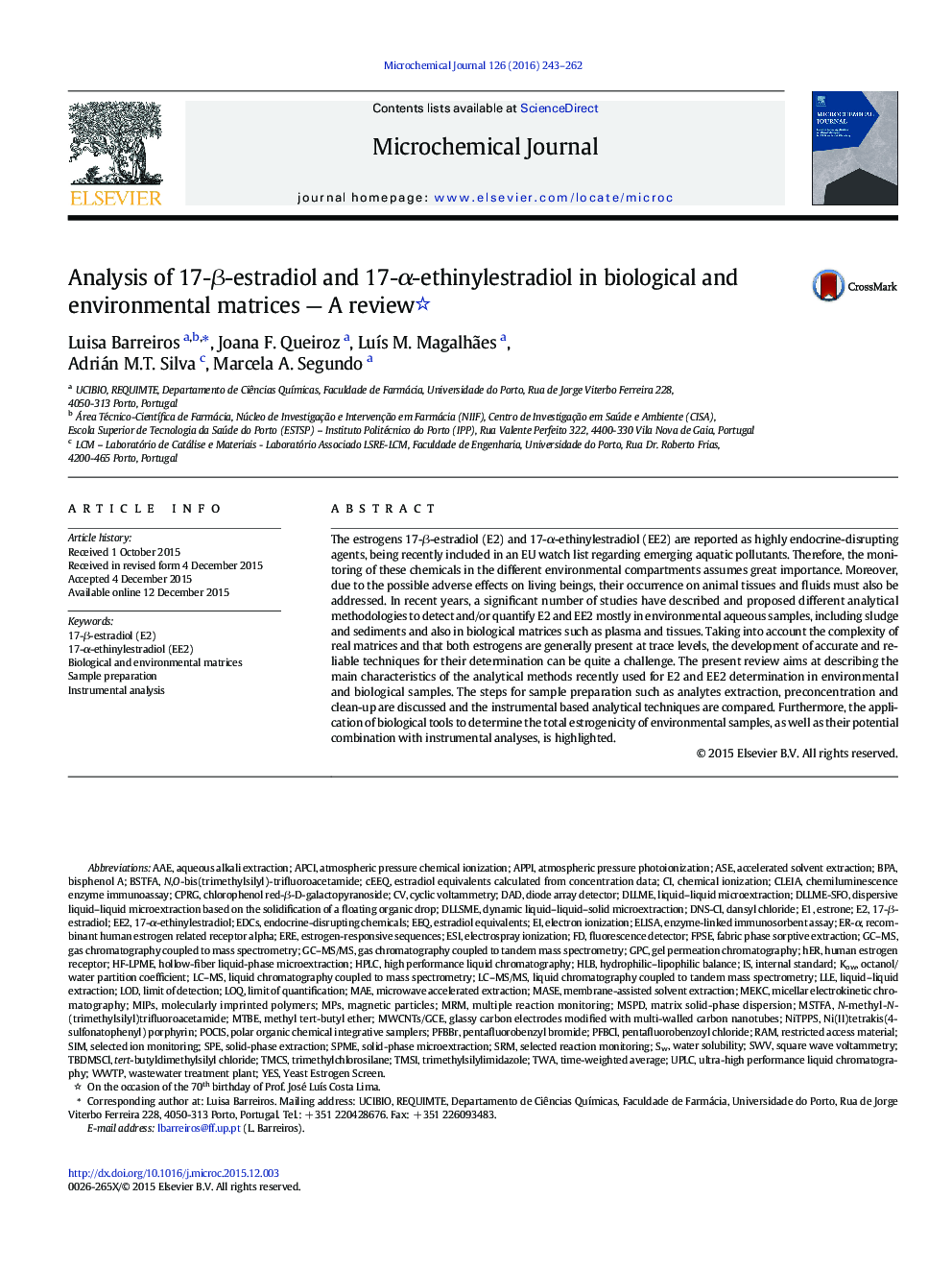| Article ID | Journal | Published Year | Pages | File Type |
|---|---|---|---|---|
| 7641484 | Microchemical Journal | 2016 | 20 Pages |
Abstract
The estrogens 17-β-estradiol (E2) and 17-α-ethinylestradiol (EE2) are reported as highly endocrine-disrupting agents, being recently included in an EU watch list regarding emerging aquatic pollutants. Therefore, the monitoring of these chemicals in the different environmental compartments assumes great importance. Moreover, due to the possible adverse effects on living beings, their occurrence on animal tissues and fluids must also be addressed. In recent years, a significant number of studies have described and proposed different analytical methodologies to detect and/or quantify E2 and EE2 mostly in environmental aqueous samples, including sludge and sediments and also in biological matrices such as plasma and tissues. Taking into account the complexity of real matrices and that both estrogens are generally present at trace levels, the development of accurate and reliable techniques for their determination can be quite a challenge. The present review aims at describing the main characteristics of the analytical methods recently used for E2 and EE2 determination in environmental and biological samples. The steps for sample preparation such as analytes extraction, preconcentration and clean-up are discussed and the instrumental based analytical techniques are compared. Furthermore, the application of biological tools to determine the total estrogenicity of environmental samples, as well as their potential combination with instrumental analyses, is highlighted.
Keywords
BPAESISRMLOQWWTPLLEAPCISPEASEAPPIHLBBSTFADADMRMAAEUPLCMSPDDLLMEGPCMTBEEE217-α-ethinylestradiolMIPSERETWAPocisER-αSWVEEQPFBBrTMCsCLEIAN,O-bis(trimethylsilyl)-trifluoroacetamideFabric phase sorptive extractionMEKCMSTFATMSIDLLME-SFOMASESPMETBDMSClN-methyl-N-(trimethylsilyl)trifluoroacetamideCPRGchlorophenol red-β-d-galactopyranosideDNS-Clpentafluorobenzoyl chloride17-β-estradiolEDCsGC–MSGC–MS/MSHF-LPMELC–MSLC–MS/MSLiquid–liquid microextractionAtmospheric pressure photoionizationdiode array detectorSample preparationchemiluminescence enzyme immunoassayEstradiol equivalentsinternal standardMembrane-assisted solvent extractionSolid-phase extractionLiquid–liquid extractionEstroneHERMAEYESBisphenol Asolid-phase microextractionInstrumental analysistert-butyldimethylsilyl chlorideTrimethylchlorosilaneELISAEnzyme-linked immunosorbent assayWastewater treatment planthydrophilic–lipophilic balanceLOD یا Limit of detectionwater solubilityDansyl chlorideMagnetic particlesRamSIMaccelerated solvent extractionYeast Estrogen ScreenOctanol/water partition coefficientfluorescence detectorMatrix solid-phase dispersionmethyl tert-Butyl etherlimit of quantificationlimit of detectionrestricted access materialEndocrine-disrupting chemicalsMolecularly imprinted polymerstime-weighted averagehollow-fiber liquid-phase microextractionselected reaction monitoringselected ion monitoringmultiple reaction monitoringMPsCyclic voltammetrySquare Wave VoltammetryPentafluorobenzyl bromideMicellar electrokinetic chromatographyhigh performance liquid chromatographyUltra-high performance liquid chromatographyliquid chromatography coupled to mass spectrometryliquid chromatography coupled to tandem mass spectrometryHPLCGel permeation chromatographygas chromatography coupled to mass spectrometryKowHuman estrogen receptorelectrospray ionizationelectron ionizationchemical ionizationatmospheric pressure chemical ionization
Related Topics
Physical Sciences and Engineering
Chemistry
Analytical Chemistry
Authors
Luisa Barreiros, Joana F. Queiroz, LuÃs M. Magalhães, Adrián M.T. Silva, Marcela A. Segundo,
